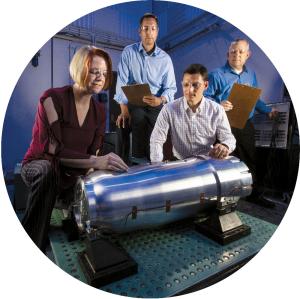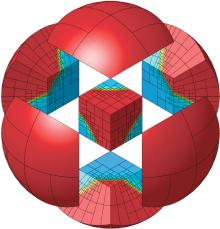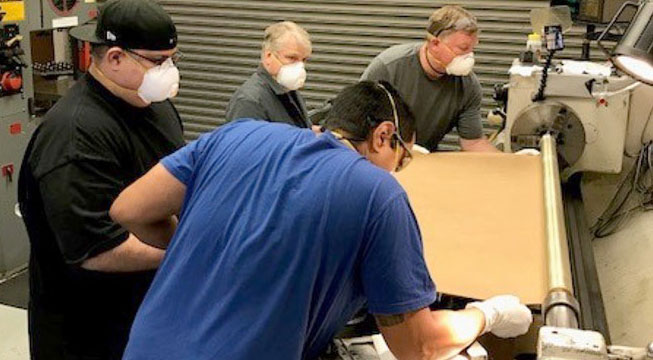LLNL's foremost responsibility is to ensure the performance of the nation's nuclear arsenal. The knowledge gained through experiments, theory, and simulations is applied to assess the condition of stockpile weapons and to develop and certify needed modifications with confidence in the absence of additional nuclear tests.
Annual Stockpile Assessment
In FY 2020, LLNL completed Cycle 25 of the annual stockpile assessment. The process included a formal comprehensive peer review by the nuclear design laboratories (Livermore and Los Alamos) of each other’s weapon systems. Experiments performed by Laboratory scientists and enhancements to physics and engineering simulation codes improved predictability and strengthened the technical foundation that supports assessments and certification of weapons. LLNL also completed needed surveillance and analysis activities to assess the condition of and sustain the B83-1, W80-1, and W87-0 stockpile systems.
Stockpile Modernization Programs
LLNL is partnered with Sandia National Laboratories as the design agencies to develop and certify the W80-4 warhead for the bomber-delivered Long-Range Standoff missile. The Laboratory is making excellent progress in the life-extension program (LEP), which is about halfway through Phase 6.3 (engineering development). In addition to numerous design reviews, major efforts focused on issuing engineering releases to the production plants and supporting concurrent activities of the U.S. Air Force and its contractors. The design of the nuclear explosives package (NEP) is mature and only one major downselect decision remains. The plans to refurbish or replace aging components and materials include use of new manufacturing methods that minimize costs, increase throughput, and reduce the use of environmentally sensitive materials and processes.
In FY 2020, the W87-1 modernization program passed its first key milestone in Phase 6.2 (program feasibility)—a review of customer requirements—keeping the Laboratory’s effort on schedule despite the COVID-19 pandemic. LLNL is NNSA’s design agency for the NEP for a ballistic-missile warhead to replace the aging W78. To be deployed the U.S. Air Force’s Ground Based Strategic Deterrent in 2030, the W87-1 will be the first modern warhead that is 100 percent newly manufactured. Technical activities are focusing on maturing weapon design options and modern manufacturing methods. The W80-4 and W87-1 programs require the full array of NNSA’s computational, experimental, and manufacturing capabilities to meet all the prototyping, proof-of-concept testing, and certification requirements.
Sierra Supercomputer and Beyond
Livermore Computing suffered no interruptions in service due to COVID-19. All classified and unclassified computers were available throughout the year, together with user support. Sierra, the world’s third fastest supercomputer on the TOP500 List, makes possible higher-fidelity, more predictive simulations of weapon performance and it provides the ability to run large ensembles of simulations to quantify uncertainties in predictions. This latest NNSA Advanced Simulation and Computing (ASC) Program machine achieves its tremendous speed by using graphics processor units together with central processing units in a heterogeneous architecture. Simulations of high importance for classified work are running more than 10 times faster on a per node basis. Sierra is providing vital support to the stockpile modernization efforts by making high-resolution 3D simulations routine.
LLNL is also preparing for the delivery in 2023 of El Capitan, NNSA’s first exascale supercomputer. With its advanced computing and graphics processing units, El Capitan’s peak performance is expected to exceed 2 exaflops (quintillion calculations per second). It will run complex simulations much faster than Sierra and operate with 4 times higher energy efficiency. The Laboratory also led ASC’s Commodity Technology System CTS-2 acquisition project, which sets the path for the NNSA laboratories’ cluster computer purchases for the next 4 or 5 years. The classified Magma cluster, LLNL’s last procurement under CTS-1, arrived in 2020.
Stockpile Stewardship Experiments
On May 7, 2020, LLNL’s High Explosives Applications Facility conducted its first high-explosives experiment under new work controls to ensure worker safety in response to the COVID-19 pandemic. In mid-July, experimenters fired the first full-scale hydrodynamic test at Site 300’s Contained Firing Facility (CFF). Both of these experiments supported stockpile modernization and successfully met all test objectives. Despite the pandemic and later regional wildfires, hazardous air quality, and extreme heat, nearly 50 experiments were conducted at Site 300 in FY 2020, including an integrated weapons experiment that provided key data that supported a critical design decision for the W80-4 LEP. CFF is the only facility in the NNSA complex that could accommodate the configuration and hazards associated with this experiment.
Experiments at the Joint Actinide Shock Physics Experimental Research (JASPER) Facility and the National Ignition Facility (see Stockpile Stewardship HED Science Experiments) provide essential data about plutonium and other materials at extreme conditions. JASPER experiments in FY 2020 studied an accelerated aged sample of plutonium equivalent to 270 years old.
Pulsed Power Modules for Subcritical Experiments
Despite COVID-19 challenges, LLNL researchers assembled and qualified 16 prototype pulsed power modules for the Los Alamos (LANL)-led Scorpius project. Scorpius aims to generate four high-quality radiographic images in subcritical experiments at the Nevada National Security Site (NNSS). In July, four similarly designed megajoule-class pulsed power modules were delivered to NNSS for another novel diagnostic capability being developed by LANL, NNSS, and LLNL.









